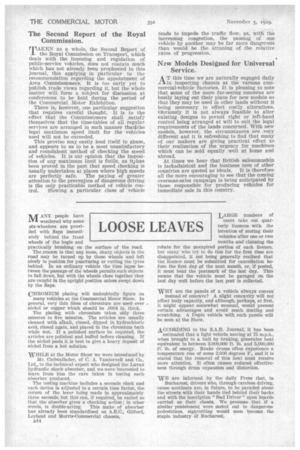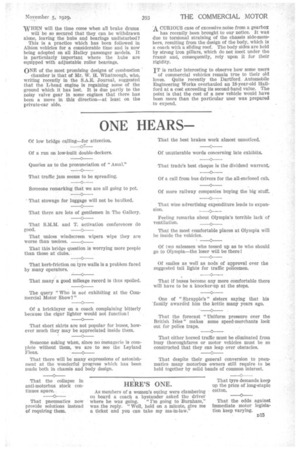M ANY people have wondered why some six-wheelers are provided with
Page 112

Page 113

If you've noticed an error in this article please click here to report it so we can fix it.
flaps immediately behind the front wheels of the bogie and practically brushing on the surface of the road. The_reason is that any loose, sharp objects in the road may be turned up by these wheels and left nicely in position for puncturing or cutting the tyres behind. In an ordinary vehicle the time lapse between the passage of the wheels permits such objects to fall down, but with the wheels close together they are caught in the upright position unless swept down by the flaps.
CHROMIUM plating will undoubtedly figure on many vehicles at the Commercial Motor Show. In general, very thin films of chromium are used over nickel or copper which should be .0004 in. thick. The plating with chromium takes only three minutes to live minutes. The articles are usually cleaned with alkali, rinsed, dipped in hydrochloric acid, rinsed again, and placed in the chromium bath while wet. If a polished surface be required, the articles are polished and buffed before cleaning. If the nickel peels it is best to give a heavy deposit of nickel from a hot soluin.
WHILE at the Motor Show we were introduced by
Mr. Cadwallader, of C. A. Vandervell and Co., Ltd, to the technical expert who designed the Luvax hydraulic shock absorber, and we were interested to learn from him the care taken in testing each. absorber. produced. The testing machine includes a seconds clock and each device is adjusted to a certain time factor, the return of the lever being made in approximately three seconds, but this can, if required, be varied so that the absorber gives a checking action; in other words, is double-acting. This make of absorber has already been standardized on A.E.C., Gifford, Leyland and Morris-Commercial chassis, D14 LARGE numbers of users take out quarterly licences with the intention of storing their vehicles after one or two months and claiming the rebate for the unexpired portion of each licence, but many who try to do this for the first time are disappointed, it not being generally realized that the licence must be submitted for cancellation before the first day .of the next month, or, if posted, it must bear the postmark of the last day. This means that the vehicle must be garaged on the last day well before the last post is collected.
WHY are the panels of a vehicle always convex
instead of concave? A slight concavity will not affect body capacity, and although, perhaps, at first, it might appear somewhat unusual, would present certain advantages and avoid much denting and scratching. A Duple vehicle with such panels will be seen at the Show.
ACCORDING to the S.A.E. Journal, it has been estimated that a light vehicle moving at 75 m.p.h., when brought to a halt by braking, generates heat equivalent to between 3,000,000 ft. lb. and 5,000,000 ft lb. of energy. Brake drums often experience a temperature rise of some 2,000 degrees F., and it is stated that the removal of this heat must receive more attention. It often causes reduced effectiveness through drum expansion and distortion.
WE are informed by the daily Press that, in Bucharest, drivers who, through careless driving, cause accidents are, in future, to be paraded about the streets with their hands tied behind their backs and with the inscription "Bad Driver" upon boards carried on their chests. We presume that if a similar punishment were meted out to dangerous pedestrians, signwriting would soon become the staple industry of Bucharest. '
WHEW will the time come when all brake drums will be so secured that they can be withdrawn alone, leaving the hubs and bearings undisturbed? This is a practice which has been followed in Albion vehicles for a considerable time and is now being adopted on all Halley passenger models. It is particularly important where the hubs are equipped with adjustable roller bearings.
ONE of the most promising designs of combustion chamber is that of Mr. W. H. Whatmough, who, writing recently in the S.A.E. Journal, suggested that the L-head engine is regaining some of the ground which it has lost. It is due partly to the noisy valve gear in some engines that there has been a move in this direction—at least on the private-car side. A CURIOUS case of excessive noise from a gearbox has recently been brought to our notice. It was due to torsional straining of the chassis side-members, resulting from the design of the body, which is a coach with a sliding roof. The body sides are held by strong iron pillars, which do not meet under the framb and, consequently, rely upon it for their rigidity.
IT is rather interesting to observe how some users of commercial vehicles remain true to their old loves. Quite recently the Dartford Automobile Engineering Works overhauled an 18-year-old Hallford at a cost exceeding its second-hand value. The point is that the cost of a new vehicle would have been more than the particular user was prepared to expend.




































































































































































































































































